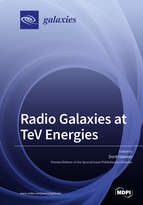Radio Galaxies at TeV Energies
A special issue of Galaxies (ISSN 2075-4434).
Deadline for manuscript submissions: closed (1 December 2019) | Viewed by 29067
Special Issue Editor
Special Issue Information
Dear Colleagues,
The majority of the known extragalactic sky at TeV gamma-ray energies consists of blazars having plasma jets pointing in the direction of the line-of-sight, which results in a large Doppler boosting of their emission. Up to now, only five galaxies with a larger viewing angle have been detected in the TeV range. These objects show also fascinating properties such as fast variability or spectral features and are called “radio galaxies”.
These TeV radio galaxies provide a unique laboratory for studying key aspects of active galactic nuclei, e.g., the connection between the jet and the black hole, the jet base, the acceleration and radiation physics in the jet, or the origin and location of the high-energy emission. Taking the assumption of the so-called “unified model” that the difference between blazars and radio galaxies lies in the viewing angle, one can directly infer the physics of blazars from studying radio galaxies.
This Special Issue of Galaxies targets radio galaxies at TeV energies. For this Special Issue, we invite researchers to submit papers dealing with observational results, models, and theoretical interpretation of TeV radio galaxies.
References:
- Acciari, V.A.; Aliu, E.; Arlen, T.; Bautista, M.; Beilicke, M.; Benbow, W.; Bradbury, S.M.; Buckley, J.H.; Bugaev, V.; Butt, Y.; et al. Radio Imaging of the Very-High-Energy gamma-Ray Emission Region in the Central Engine of a Radio Galaxy. Science 2009, 325, 444.
- Aleksić, J.; Ansoldi, S.; Antonelli, L. A.; Antoranz, P.; Babic, A.; Bangale, P.; Barrio, J. A.; González, J. Becerra; Bednarek, W.; Bernardini, E.; et al. Black hole lightning due to particle acceleration at subhorizon scales. Science 2014, 346, 1080.
- Rieger, F. Gamma-rays from non-blazar AGN. AIP Conference Proceedings 2017, 1792, 020008.
Dr. Dorit Glawion
Guest Editor
Manuscript Submission Information
Manuscripts should be submitted online at www.mdpi.com by registering and logging in to this website. Once you are registered, click here to go to the submission form. Manuscripts can be submitted until the deadline. All submissions that pass pre-check are peer-reviewed. Accepted papers will be published continuously in the journal (as soon as accepted) and will be listed together on the special issue website. Research articles, review articles as well as short communications are invited. For planned papers, a title and short abstract (about 100 words) can be sent to the Editorial Office for announcement on this website.
Submitted manuscripts should not have been published previously, nor be under consideration for publication elsewhere (except conference proceedings papers). All manuscripts are thoroughly refereed through a single-blind peer-review process. A guide for authors and other relevant information for submission of manuscripts is available on the Instructions for Authors page. Galaxies is an international peer-reviewed open access semimonthly journal published by MDPI.
Please visit the Instructions for Authors page before submitting a manuscript. The Article Processing Charge (APC) for publication in this open access journal is 1400 CHF (Swiss Francs). Submitted papers should be well formatted and use good English. Authors may use MDPI's English editing service prior to publication or during author revisions.
Keywords
- Radio galaxies
- TeV gamma-rays






